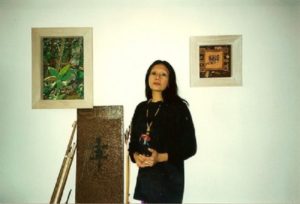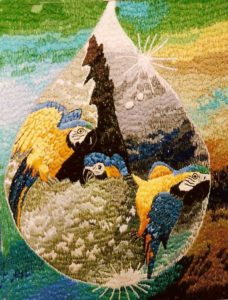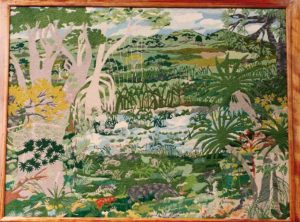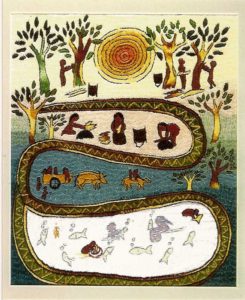
For indigenous Guyanese Genevieve Cox, whose hand- embroidered artwork depicts her indigenous cultures, her embroidery is being used as art to showcase what she calls, “the natural world, stories and customs of the Atorad (Atorai), Wapishana and Arawak” nations.
According to Cox, “Embroidery is not a native craft but it is the medium closest to weaving, and has its roots in basket making, mat making and sewing.” Embroidery was introduced by Guyana’s British colonial rule.
While hand-made embroidery has a rich history dating back to the 5th century BC, over the years,following its European enforcement in the 19th – early 20th century as a “feminine”, “civilized” activity for “proper young ladies”, it had become synonymous with female restrictions, social class,and colonialism.
However, the feminine revolution of the mid-20th century has since seen hand-made embroidery as a voice for women in contemporary society, though as a craft it still struggles for its right to be an art form.
“The slow ritual of creation is very important, as is texture, as the work slowly emerges. The works are hand stitched using the satin stitch technique. One piece of work may take 200 hours to complete. The making of the embroidery is as important as the final result,” Cox states of her work.
Genevieve Cox was born with a rich Atorad, Wapishana and Arawak cultural heritage: her mother was Arawak and her father Atorad and Wapishana. Her embroidery depicts her celebration of and concerns for her heritage in today’s world. It also illustrates traditional stories.
“Stories have been passed orally down through the generations, she notes, “I feel the need to document these stories or they could be lost. Customs are changing as the Amerindians move into the contemporary western culture, and they too will be lost and forgotten if we do not preserve them.”
Cox has exhibited in the Caribbean and internationally, and she has also been the recipient of numerous awards over her more than 30 years of embroidery experience. Her work can also be found on book covers, including the 1996 edition of “The Penguin Book of Caribbean Short Stories” by Penguin Books.
According to Angie Kordic in “Embroidery Art: More and more common in contemporary expression”, today, we can talk about embroidery as a full-on method of expression, involving skills and strong social and political messages.
Cox is one of those women who finds expression through her embroidery. “I have a fundamental concern for the destruction of the rain forest, through logging, mining and road building. I would like people to see the beauty and fragility of the eco system and the need to preserve it,” she states of her work, which blends tradition, history and contemporary expression into painstaking and beautiful embroidery that can only be considered works of art.






